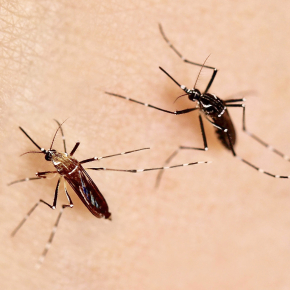
Greater mosquito susceptibility to Zika virus fueled the epidemic
The Zika virus has spread around the world over the last decade, causing millions of infections, some of which have been associated with congenital abnormalities and neurological disorders. Scientists from the CNRS, the Institut Pasteur, and the IRD1 turned their attention to the main vector of the virus, the mosquito Aedes aegypti. Between 5,000 and 10,000 years ago, this mosquito species native to Africa gave rise to a human-adapted subspecies that spread to other continents during the last centuries. The invasive subspecies is believed to have become a major vector of viruses, including those responsible for yellow fever and dengue, because of its marked preference for human blood. By experimentally comparing wild populations of Ae. aegypti from different regions of the globe, the researchers discovered that the invasive subspecies is very effective at transmitting the Zika virus not only because it has more frequent contacts with humans for blood meals, but also as a result of its greater susceptibility to the virus relative to the African subspecies. These findings, which are published in Science (November 20, 2020), provide an explanation to the lack of major Zika outbreaks in Africa until now. They also shed new light on the emergence of the virus and on the regional and continental differences in its public health impact.

- 1The researchers hail from the Evolutionary Genomics, Modeling, and Health unit (CNRS / Institut Pasteur), MIGEVEC (CNRS / IRD / University of Montpellier), the Mouse Genetics Laboratory (Institut Pasteur), the Institut Pasteur de Guyane, the Institut Pasteur de Guadeloupe, the Institut Pasteur du Cambodge and the Institut Pasteur de Dakar , the QIMR Berghofer Medical Research Institute (Australia), the Princeton University (USA), the Fundación Universidad del Norte (Colombia), the Centre Interdisciplinaire de Recherches Médicales de Franceville (Gabon), the Uganda Virus Research Institute (Uganda), the MRC-University of Glasgow Centre for Virus Research (UK), the Armed Forces Research Institute of Medical Sciences (Thailand), the Université Cheikh Anta Diop (Senegal), the Kenya Medical Research Institute (Kenya), the Centers for Disease Control and Prevention (USA), the Institut Louis Malardé (French Polynesia), and the Walter Reed Army Institute of Research (USA).
Enhanced Zika virus susceptibility of globally invasive Aedes aegypti populations. Fabien Aubry, Stéphanie Dabo, Caroline Manet, Igor Filipović, Noah H. Rose, Elliott F. Miot, Daria Martynow, Artem Baidaliuk, Sarah H. Merkling, Laura B. Dickson, Anna B. Crist, Victor O. Anyango, Claudia M. Romero-Vivas, Anubis Vega-Rúa, Isabelle Dusfour, Davy Jiolle, Christophe Paupy, Martin N. Mayanja, Julius J. Lutwama, Alain Kohl, Veasna Duong, Alongkot Ponlawat, Massamba Sylla, Jewelna Akorli, Sampson Otoo, Joel Lutomiah, Rosemary Sang, John-Paul Mutebi, Van-Mai Cao Lormeau, Richard G. Jarman, Cheikh T. Diagne, Oumar Faye, Ousmane Faye, Amadou A. Sall, Carolyn S. McBride, Xavier Montagutelli, Gordana Rašić, Louis Lambrechts. November 20, 2020. Science. DOI : 10.1126/science.abd3663
https://science.sciencemag.org/content/370/6519/991


